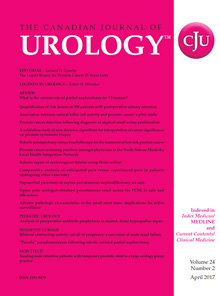 Indexed in Index Medicus and Medline
Indexed in Index Medicus and Medline
HOW I DO IT
-
Single-port robotic laparoscopic ureterocalicostomy: surgical technique and clinical outcomes
Xu J. Alex, Lin S. Jeffery, Chen Yen Po, Carbunaru Samuel, Lee S. Yeonsoo, Zhao C. Lee Department of Urology, NYU Langone Health, New York, New York, USA
Introduction: We describe a method of robotic ureterocalicostomy (RALUC) with the Da Vinci Single Port (SP) platform and present clinical outcomes in our cohort of patients. Materials and methods: We retrospectively reviewed all patients undergoing RALUC with the SP platform in a single-institution, IRB-approved database between 2020-2023. Demographics, preoperative, intraoperative, and postoperative outcomes were collated. Surgical success was defined as freedom from hardware, avoidance of additional surgical reconstruction, and no obstruction on follow up imaging/ureteroscopy. An incision is made 1/3rd the distance from anterior superior iliac spine to the umbilicus. The retroperitoneal space is entered and SP Access Port is placed. The psoas is identified and concomitant ureteroscopy is used to identify the ureter. The ureter is dissected to the most proximal aspect and transected. The remaining proximal ureteral stump is suture ligated. The lower pole parenchyma is removed to access the calyx. Absorbable barbed suture is used to control parenchymal bleeding and evert the mucosal edge of the calyx. Barbed suture is then used for the ureterocaliceal anastomosis over a ureteral stent. Results: Six patients underwent RALUC. Retroperitoneal approach was used for 5/6 cases. Prior ureteral surgery had been performed in 4/6 patients. Fifty percent of cases included an additional procedure with a median operative time of 248 minutes. One patient required nephrostomy tube placement postoperatively. Median follow up was 10.35 months with surgical success rate of 67%. Conclusions: SP RALUC is a safe and feasible option for proximal ureteral reconstruction in patients with unfavorable upper urinary tract anatomy or in salvage cases.
Keywords: robotics, reconstruction, ureterocalicostomy, ureteral reconstruction, pyeloplasty,
Dec 2024 (Vol. 31, Issue 6 , Page 12072)PDF (809.4KB)Free -
How I do it: Aquablation in very large prostates (> 150 mL)
Helfand T. Brian, Kasraeian Ali, Sterious Steve, Glaser P. Alexander, Talaty Pooja, Alcantara Miguel, Alcantara Mola Kaitlyn, Higgins Andrew, Ghiraldi Eric, Elterman S. Dean Department of Surgery, NorthShore University Health System, Evanston, Illinois, USA
Aquablation has been well-studied in prostates sizes up to 150 mL. Recently, American Urological Association guidelines distinguish surgical interventions for men with large prostates (80 mL-150 mL) and now very large prostates (> 150 mL). Readers will gain an understanding of how to use Aquablation in the very large prostate size category.
Keywords: robotics, LUTS, BPH, aquablation, prostate surgery, urology,
Apr 2022 (Vol. 29, Issue 2 , Page 11111)PDF (1.97MB)Free -
Robotic intracorporeal orthotopic neobladder in the supine Trendelenburg position: a stepwise approach
Bhattu S. Amit, Ritch R. Chad, Jahromi Mona, Banerjee Indraneel, Gonzalgo L. Mark, MD Department of Urology, University of Miami Miller School of Medicine, Miami, Florida, USA
Robotic radical cystectomy with urinary diversion has become increasingly utilized for the surgical management of bladder cancer. Orthotopic neobladder reconstruction is still performed worldwide primarily via an extracorporeal approach because of the difficulty associated with robotic intracorporeal reconstruction. The objective of this article is to demonstrate a stepwise approach for robotic intracorporeal neobladder in a standardized manner that adheres to the principles of open surgery.
Keywords: robotics, intracorporeal, neobladder, supine, patient positioning, orthotopic, table motion,
Aug 2021 (Vol. 28, Issue 4 , Page 10794)PDF (1.26MB)Free -
Single port robotic radical prostatectomy with the da Vinci SP platform: a step by step approach
Jones Rabun, Dobbs W. Ryan, Halgrimson R. Whitney, Vigneswaran T. Hari, Madueke Ikenna, Wilson Jessica, Abern R. Michael, Crivellaro Simone, MD Department of Urology, University of Illinois at Chicago, Chicago, Illinois, USA
The da Vinci single port (SP) robotic system (Intuitive Surgical, Sunnyvale, CA, USA) is a recently approved robotic platform designed with several modifications to the previously available multi-port robotic systems. This article describes the technique performed utilizing the SP robotic system for radical robotic-assisted laparoscopic prostatectomy (RALP) with or without bilateral pelvic lymph node dissection from a single institution. In this report we describe our step-by-step approach, technical modifications from the multi-port technique and initial results for performing single port robotic-assisted laparoscopic prostatectomy (SP-RALP). We describe our initial experience and technique with the SP robotic system consisting of 23 consecutive patients who underwent SP-RALP between December 2018 and May 2019. The median patient age was 62 years with approximately half of the patients undergoing pelvic lymphadenectomy. The median operative time was 236 minutes, median estimated blood loss was 50 mL and median length of hospital stay was 1 day. No unplanned port placements occurred and no conversions to open surgery occurred. We demonstrate the safety and feasibility of performing a transperitoneal prostatectomy with either a posterior or anterior approach.
Keywords: robotics, protate neoplasms, minimally invasive surgical procedures,
Jun 2020 (Vol. 27, Issue 3 , Page 10263)PDF (703.9KB)Free -
Partial nephrectomy: novel closure technique using bovine pericardium
Uhlman A. Matthew , Brown A. James, MD Department of Urology, University of Iowa, Iowa City, Iowa, USA
Partial nephrectomy (PN) has gained popularity over the past two decades as an alternative to radical nephrectomy (RN) in patients with small renal masses. Morbidity and mortality from PN have been shown to be lower than from RN, while oncologic outcomes have been shown to be equivalent for tumors < 7 cm. PN has become increasingly popular in academic centers, but the general urologic community continues to lag behind. The reason for this is not known, but may be related to the relatively high complication rate, including delayed complications associated with inadequate closure. Here we describe a novel PN closure technique that provides additional strength and hemostasis by incorporating bovine pericardium.
Keywords: surgical techniques, novel closure, penile carcinoma, laparoscopy, robotics,
Oct 2012 (Vol. 19, Issue 5 , Page 6485)



